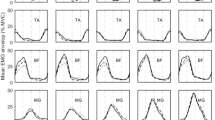Abstract
The aim of the present study was to compare physiological data obtained during cycling using a noncircular "Harmonic" chainring versus a standard circular chainring over a range of speeds and slopes in endurance-trained cyclists. Thirteen male subnational cyclists (16–45 years) performed two maximal graded exercises on their own bicycle: one with a circular chainring, the other with a Harmonic chainring with the same gearwheel (52 teeth). The two chainrings were randomly assigned to avoid learning effects. The tests were carried out on a simulator. Speeds and/or slopes were increased every 2 min 30 s until exhaustion of the subject. Ventilation, oxygen uptake, carbon dioxide output, respiratory exchange ratio, and heart rate were continuously measured during the tests. Blood lactate concentration was measured during the last 30 s of each level. No significant difference was observed in any of the submaximal parameters measured during the tests (P>0.05). Similarly, maximal values were not statistically different (P>0.05). In conclusion, although the design of the Harmonic chainring was based on optimization analysis, comparison of the physiological response in this study did not translate into an advantage of the Harmonic over circular chainring during submaximal and maximal pedaling in trained cyclists.

Similar content being viewed by others
References
Astrand PO, Rodahl K (1986) Textbook of work physiology. McGraw-Hill, New York
Barani D, Commandre F, Digoin A (1994) The "Harmonic" chainring: presentation and biomechanical characteristics (in French). Med Sport 68:77–81
Berthoin S, Allender H, Baquet G, Dupont G, Matran R, Pelayo P, Robin H (2003) Plasma lactate and plasma volume recovery in adults and children following high-intensity exercises. Acta Paediatr 92:283–290
Coyle EF, Feltner ME, Kautz SA, Hamilton MT, Montain SJ, Baylor AM, Abraham LD, Petrek GW (1991) Physiological and biomechanical factors associated with elite endurance cycling performance. Med Sci Sports Exerc 23:93–107
Cullen LK, Andrew K, Lair M, Widger MJ, Timson BF (1992) Efficiency of trained cyclists using circular and noncircular chainrings. Int J Sports Med 13:264–269
Ericson MO, Nisell R (1988) Efficiency of pedal forces during ergometer cycling. Int J Sports Med 9:118–122
Henderson SC, Ellis RW, Klimovitch G, Brooks GA (1977) The effects of circular and elliptical chainwheels on steady-rate cycle ergometer work efficiency. Med Sci Sports Exerc 9:202–207
Hintzy F, Belli A, Rouillon JD, Grappe F (2000) Effects of non-circular chainwheel on force-velocity relationship during sprinting on a cycle ergometer (in French). Sci Motricité 40:42–47
Hue O, Galy O, Hertogh C, Casties JF, Prefaut C (2001) Enhancing cycling performance using an eccentric chainring. Med Sci Sports Exerc 33:1006–1010
Hull ML, Kautz S, Beard A (1991) An angular velocity profile in cycling derived from mechanical energy analysis. J Biomech 24:577–586
Hull ML, Williams M, Williams K, Kautz S (1992) Physiological response to cycling with both circular and noncircular chainrings. Med Sci Sports Exerc 24:1114–1122
Kautz SA, Neptune RR (2002) Biomechanical determinants of pedaling energetics: internal and external work are not independent. Exerc Sport Sci Rev 30:159–165
Miller NR, Ross D (1980) The design of variable ratio chain drives for bicycle and ergometers: application to a maximum power bicycle drive. In: Shoup T, Thacker J (eds) Proceedings of International Conferences on Medical Devices and Sports Equipment. American Society for Mechanical Engineers, New York, pp 49–56
Neptune RR, Herzog W (2000) Adaptation of muscle coordination to altered task mechanics during steady-state cycling. J Biomech 33:165–172
Neptune RR, Kautz SA, Zajac FE (2000) Muscle contributions to specific biomechanical functions do not change in forward versus backward pedaling. J. Biomech 33:155–164
Okajima S (1983) Designing chainweels to optimize the human engine. Bike Tech 2:1-7
Patterson RP, Moreno MI (1990) Bicycle pedaling forces as a function of pedaling rate and power output. Med Sci Sports Exerc 22:512–516
Ryan MM, Gregor RJ (1992) EMG profiles of lower extremity muscles during cycling at constant workload and cadence. J Electromyogr Kinesiol 2:69–80
Acknowledgements
The authors gratefully acknowledge the cooperation of the TECHNI CYCLES team, particularly William Bergheaud for his expert technical assistance. Additionally, appreciation is given to the subjects for their patience, time and effort.
Author information
Authors and Affiliations
Corresponding author
Rights and permissions
About this article
Cite this article
Ratel, S., Duché, P., Hautier, C.A. et al. Physiological responses during cycling with noncircular "Harmonic" and circular chainrings. Eur J Appl Physiol 91, 100–104 (2004). https://doi.org/10.1007/s00421-003-0937-9
Accepted:
Published:
Issue Date:
DOI: https://doi.org/10.1007/s00421-003-0937-9




